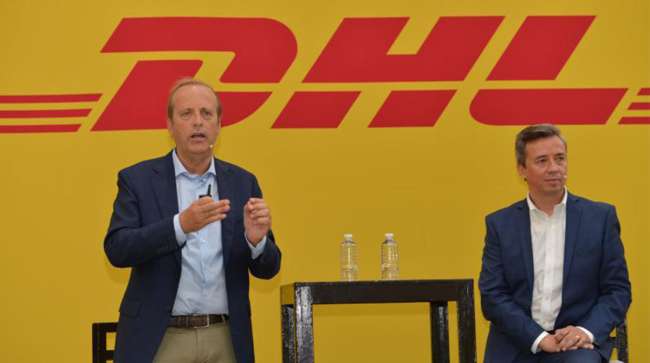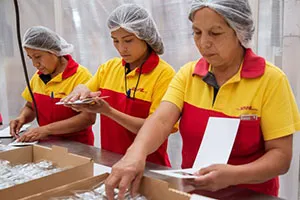Senior Reporter
DHL Plans Expansion in Latin America

[Stay on top of transportation news: Get TTNews in your inbox.]
Five Latin American nations could share $556 million by 2028 as contract logistics provider DHL Supply Chain announced July 12 it is seeking to expand its regional fulfillment network. The company said it is seeking to get closer to consumers and provide more sector-specific logistics services to its shipping partners.
The Bonn, Germany-based company said this investment in Mexico, Brazil, Colombia, Peru and Argentina also is intended to develop greener warehouses and decarbonize its transportation fleet.
Deutsche Post DHL ranks No. 3 on the Transport Topics Top 50 list of the largest global freight companies. DHL Supply Chain ranks No. 12 on the TT Top 100 list of the largest logistics companies in North America.
The company’s leadership said the move is part of a plan that is larger than traditional nearshoring. DHL is omni-sourcing operations to several nations to provide additional resources and grow the distribution network.
Despite the post-COVID pandemic move toward more nearshoring, specifically in Latin America, this is not a one-size-fits-all proposition, DHL said.
Always make sure that you design your supply chain with more than one sourcing point.
DHL Global Supply Chain CEO Oscar de Bok
Image
“Omni-sourcing makes sure that customers would source their components from more than one source point, or more than one country at the same time,” DHL Supply Chain’s global CEO Oscar de Bok said during a Mexico City news conference. He believes more of DHL’s customers are taking the same approach to determine where to build and expand facilities.
“You cannot depend on one source. That’s why I say that it’s different from nearshoring, which is only getting close to your end market,” he said. “Always make sure that you design your supply chain with more than one sourcing point for the key components of your products.”
Today we are announcing the addition of 13 new @VolvoTrucksUK bio-LNG trucks to our fleet as part of our ongoing GoGreen plan. Find out more about this latest investment here: https://t.co/b3JvW7dBHj #transport #sustainbility #trucking pic.twitter.com/ffqznKhXf4 — DHL Supply Chain (@DHLsupplychain) January 24, 2022
DHL did not release details concerning the expansion or where the company will build the new distribution facilities. However, it insists all the new warehouses in Latin America will be carbon neutral as part of its plan to be a zero-emission company by 2050 with its GoGreen Plus program.
“To cope with the trends of global trade, e-commerce, digitalization and sustainability, the customer needs flexibility and agility,” de Bok said. “This means facilities like the one we’re in today, and transport management like what you have here today, provides the flexibility and the agility to respond faster to the ever-changing and ever-unpredictable things that are happening. Supply chains need to be resilient. They need to be able to respond to changes fast.”
Already, DHL Group is spending $7.8 billion in sustainable fuel and clean technologies by 2030.
The company also recently announced that within the next four years, it will begin flying 12 electric-powered, twin-engine regional airplanes, named “Alice,” manufactured by Israel-based Eviation and capable of flying 440 miles and carrying 2,500 pounds of cargo.
DHL says battery technology has improved to the point that planes can be sufficiently recharged during the time they are on the ramp being unloaded and loaded.
When it announced its zero-emission goal, the company said it will have 80,000 electric vehicles or 60% of its worldwide fleet on the road by 2030. It will also increase its use of sustainable aviation fuels to more than 30% by 2030.
DHL Supply Chain operates 242 warehouses in Latin America covering 3 million square feet. Globally, 50% of DHL distribution facilities are carbon neutral.
In Latin America specifically, DHL plans to expand its EV fleets from 155 to 1,500 and will offer more digital freight platforms throughout the region that help shippers and carriers optimize supply chain management.
This is a model that we’re replicating from Europe and from different geographies.
Agustin Croche, CEO of DHL Supply Chain Latin America
Image
“This is a model that we’re replicating from Europe and from different geographies,” said Agustin Croche, regional CEO of DHL Supply Chain Latin America.
Earlier this summer, DHL announced it is expanding its partnership with Locus Robotics and is deploying 5,000 additional autonomous mobile robots across multiple sites. This is one of the largest autonomous mobile robot deals for the industry so far.
The company says this will provide DHL with automation technology that aims to optimize its supply chain operations and improve worker productivity, order accuracy, speed and efficiency.
“Digitalization is not only about data analytics or robotics. It’s also about how we train people, and how through simulations, we could train people faster in order to get to the service levels we need, and in order to have people grow with us in our business,” de Bok said.

DHL Supply Chain acquired Mexican life sciences firm NTA last year. (DHL Supply Chain)
According to the company, the most recent move in Latin America follows earlier investments in Brazil, Colombia and Mexico, which have helped paved the road for the new investment.
In 2017, DHL acquired Brazilian cold chain logistics providers Polar Transportes and Rio Lopes Transportes, which helped the company’s temperature-control transportation efforts in the country. It acquired warehouse and packing company provider Suppla in 2018 to bolster its Colombian operations.
DHL increased its presence in Mexico last year, acquiring another cold chain logistics provider, NTA. Primarily a life sciences industry company, NTA has expanded into other areas.
Want more news? Listen to today's daily briefing below or go here for more info:



